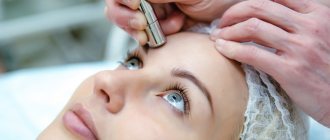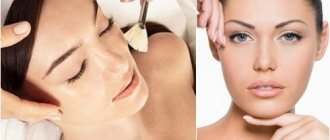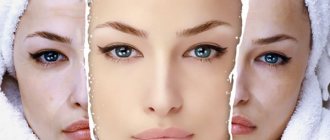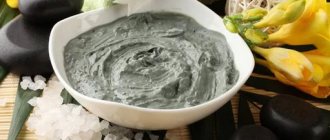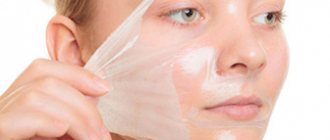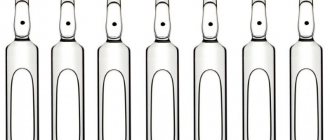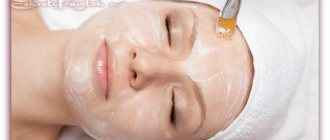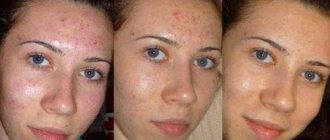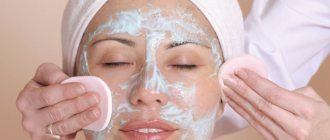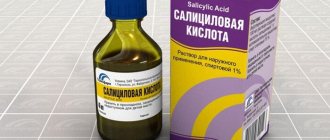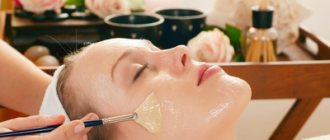Chemical peeling is a special damage to the top layer of facial skin using acid.
In other words, it is a physician-controlled burn. As a result of this procedure, epidermal cells begin to produce collagen. This helps to smooth and restore the skin. This procedure promotes very deep cleansing of makeup residues, as well as various types of other contaminants, so the cosmetologist must include chemical cleansing in the complex of rejuvenating procedures.
It should be remembered that the procedure will not help achieve the desired result if you have oily or saggy skin, as well as deep scars and freckles.
The essence of the procedure
Peeling is considered one of the most popular procedures that promote skin rejuvenation. They are used by women who want to look perfect regardless of their age.
Medium peeling is a common type of technique. It is aimed at removing dead cells in the structure of the epidermis to the basal layer. Manipulation can be carried out not only for facial care. It is often prescribed for the neck, arms, décolleté and other problem areas.
Depending on the mechanism of action, medium peeling can have the following types:
- Mechanical - in this case, skin cleansing is carried out using various abrasive compounds. To carry out the procedure, specialists use special scrubs, brushes, and enzymes. There is also a vacuum method.
- Physical – it is often called hardware. Special devices are used to conduct the session.
- Chemical – provides an effect through the use of various acids. Medium peeling brings great benefits to the dermis. With its help, it is possible to get rid of pigmentation, eliminate small wrinkles, and correct age-related changes.
Preparation
Preparing for a cosmetic procedure is a very important process.
During it, the doctor determines the required type of cleansing and adapts the skin to the selected acid. The patient may be offered both external remedies (for example, skin whitening) and internal ones (antioxidant drugs). It is also important to ensure uniform penetration of the substance into the layers of the epidermis. This preparatory work is carried out only before medium and deep types of cleaning. In this case, surface cleaning does not require any special preparation.
Before the chemical peeling procedure, the skin is cleansed to degrease it.
Indications and contraindications
Common indications for the procedure include:
- the presence of small wrinkles on the face;
- chloasma;
- freckles and pigmentation;
- facial irregularities;
- warts and papillomas;
- areas of hyperpigmentation;
- scar defects;
- formation of superficial keratomas;
- hyperkeratosis;
- symptoms of dermal aging;
- acne marks.
Medium peeling is actively used to rejuvenate the dermis and restore the structure of the epithelium. It also gives the skin freshness and copes with scars.
At the same time, manipulation is not always possible. Key limitations to the procedure include:
- open wounds on the face;
- pathologies of the heart and blood vessels;
- tendency to form scar defects;
- malignant tumors;
- diabetes;
- acute and chronic infections;
- purulent and inflammatory formations on the skin;
- bleeding disorders;
- mental pathologies.
How can the incidence of complications be reduced?
To protect yourself from complications caused by professional illiteracy, ask the cosmetologist to provide documents on education and permission to engage in this activity. Make sure that there are quality certificates for the drugs that will be used during the procedure.
The positive outcome of the peeling will largely depend on you. Strictly follow all specialist recommendations. This applies to both the preparation procedure and the care of treated skin. Do not hide the presence of contraindications from the cosmetologist.
Advantages and disadvantages of the technique
The procedure has many advantages:
- The technique is considered quite well known in cosmetology. This confirms its effectiveness.
- Peeling provides rapid achievement of noticeable results. Usually the first effect can be seen literally a week after the session.
- The results of the manipulation last for quite a long time. The effect can last from six months to 2 years.
In addition to the obvious advantages, medium peeling also has certain disadvantages. The main disadvantages of manipulation include the following:
- Pain during the session. If you compare medium peeling with superficial peeling, the discomfort will be more noticeable. A woman may experience an uncomfortable burning sensation as the acids affect the living epithelium.
- The need for a recovery period. It lasts 1 week after completion of the session.
- Undesirable reactions after the session. This type of peeling often provokes peeling and irritation of the dermis.
- Difficulty smoothing out deep expression wrinkles. Also, the procedure cannot cope with vertical wrinkles in the mouth area. To eliminate these problems, a more radical intervention will be required - contouring or Botox injections.
- Inability to eliminate crow's feet near the eyes. More serious procedures will help to cope with the problem.
- Problems with eliminating deep nasolabial folds. To do this you will have to undergo plastic surgery.
- The likelihood of impaired pigmentation of the dermis in women with dark epithelium.
Features of physical peeling
There are different options for physical peeling. The main varieties include:
- Fractional laser thermolysis. The key advantage of the fractional technique is the absence of complete irradiation of the skin. In this case, deep but microscopic rays affect the face. This helps stimulate the regeneration process and reduce the risk of complications. The procedure is carried out using a neodymium, erbium or CO2 laser. They are characterized by different wavelengths, rules for performing the procedure, and depth of impact.
- Diamond dermabrasion. In this case, the dermis is injured with a special attachment with diamond dust. This allows you to eliminate many problems - scars, pigmentation, acne, wrinkles.
- Laser dermabrasion. The mechanism of action of the manipulation is based on the absorption of laser radiation by skin cells. As a result, microscopic explosions occur in their structure. During the procedure, an erbium and CO2 laser is used.
Indications for physical peeling include various types of wrinkles, papillomas, and acne marks. The procedure is also prescribed for papillomas and warts, hyperkeratosis, and scar defects.
The recovery period after medium peeling has certain features:
- It is not recommended to remove crusts in attempts to stimulate epithelial regeneration processes.
- You should use cosmetic products for 7-10 days.
- It is important to ensure reliable skin protection from the effects of high and low temperatures.
Customer Reviews
Elena, 44 years old
I did a medium peeling - 3 times, on the 3rd day my face looked like a baked apple, before the session I applied the cream given by the doctor. The procedure is tolerable, there is a strong burning sensation, but the fan blows. After a day, you can wash your face and smear your face with pantheon or Vaseline and wash your face often, the skin will peel off faster in whole layers. After 10 days everything is fine, the only unpleasant thing (for me) is staying at home.
Anna, 40 years old
Pores have shrunk and a lifting effect is noticeable. And this is after the first time. Although the cosmetologist recommended three procedures. And I, of course, will do them, because you always want perfect skin.
Elena, 41 years old
I did a medium peel for the first time last year, before that I did the lightest ones. It’s painful, of course, but tolerable, especially since it’s fast. In terms of healing, after 10 days it’s already normal. I don't have any pigmentation either. The effect is wonderful, the skin is in excellent condition, I will skip it this year - as long as the effect does not require updating.
Types of chemical medium peeling
Medium chemical facial peeling has different types. In any case, during the procedure, special acids act on the skin. In some situations, alkalis are also used. Peeling can be single-component or multi-component. In the first case, only one type of acid is used. The multicomponent composition also contains other active components.
Medium peel with trichloroacetic acid (TCA)
TCA medium facial peeling allows you to achieve the following results:
- cleanse the skin of keratinized epithelial particles;
- achieve an antimicrobial effect;
- stop inflammation;
- activate metabolism, achieve capillary expansion.
To carry out the manipulation, special compounds are used. Usually a mixture of trichloroacetic acid with a concentration of 15% and fruit acids is used. In addition, a mixture consisting of 20% trichloroacetic acid is used.
When performing a session, you should follow these recommendations:
- First, the skin should be cleansed of cosmetics and impurities with a special lotion.
- Treat eyes and lips with a special protective agent that will help avoid the aggressive effects of acid.
- Apply peeling composition to face. TCA can be applied in more than one layer. Trichloroacetic acid is often alternated with other compounds - nourishing or moisturizing.
- Then the surface of the dermis should be moistened with a neutralizing composition, which will neutralize the residual effect of the aggressive chemical.
- Finally, the entire skin is covered with a mask with anti-inflammatory, nourishing, and moisturizing ingredients. When the effect of the composition ends, the epidermis should be lubricated with a moisturizing product.
In order for medium peeling to bring the required results, after completing the first procedure, a second one is done. However, it is allowed only after 3-4 weeks.
Medium salicylic peeling
This manipulation is also suitable for girls with dark skin. This is due to the more gentle effect of the active components on the surface of the epithelium. However, this is only true when using a 30% salicylic acid solution.
Medium salicylic peeling is performed according to the usual procedure. First, apply a sodium salicylate-based product to clean skin. Then the harm from its action is eliminated by the neutralizer. Finally, masks and creams are used that have moisturizing and soothing properties.
There are 2 methods of applying a substance containing salicylic acid:
- Soft - in this case, the epidermis is carefully treated with the drug using a cotton swab.
- Hard – the medicine is actively rubbed into the skin with a cotton pad.
The onset of peeling action is demonstrated by the appearance of a white layer on the skin. It's called frosting. Manipulation must be carried out in courses. A total of 3-4 sessions are done with an interval of 10 days. You should undergo 2-3 courses of therapy per year.
Median Jessner Peel
This term refers to mid-superficial facial peeling. The active substance has a concentration of 14% and includes the following components:
- lactic acid;
- resorcinol;
- ethanol;
- salicylic acid.
The method of application and dose of the drug depends on the thickness of the dermis and the required depth of penetration of the composition. The product is applied to thin skin with a sterile applicator. For those with thick dermis, use a gauze pad. The course of treatment includes 3-4 procedures, which are carried out at intervals of 6 weeks.
Retinoic peeling
This procedure also has a superficial-medium effect. The manipulation is often called yellow peeling. Different acids are used to conduct the session. The drug must contain retinoic acid.
Manipulation should be performed on women over 35-40 years of age. At the same time, it can be performed in the summer, which is prohibited with other types of peeling. However, in this case, you should definitely use sunscreens with a protection factor of at least 50.
A contraindication to retinoic peeling is an allergy to vitamin A. Also, the procedure is not performed for people with liver failure.
To perform the procedure, the following sequence of actions is recommended:
- First, the doctor cleanses the skin and applies a special preparatory solution to it. It must contain glycolic or salicylic acid.
- Then you can apply the peeling composition itself. A variety of substances are used to carry out the procedure. The specific remedy is selected by the doctor, taking into account the individual characteristics of the body.
You only need to keep the product on for a quarter of an hour. In this case, the doctor himself removes the remaining composition from the face. Sometimes the substance is left on the skin for 12 hours. In such a situation, a girl can wash off the product on her own, following medical recommendations.
Post-peeling effect
During chemical cleaning, active interference occurs in the processes occurring inside the skin, so you should strictly adhere to the doctor’s recommendations.
Based on the condition of your skin and other individual characteristics, the cosmetologist will determine the composition of caring creams for you personally for the first time. You will be able to return to your usual cosmetics in a few days - but only with your doctor’s permission.
After deep and medium cleaning, the patient is prohibited from going outside for several days.
In the first days in the fresh air, you should apply products with a fairly high degree of protection (30-40) to the skin, and also protect your face from direct sunlight. For this purpose, it is advised to wear a wide-brimmed hat and walk on the shady side. These recommendations must be followed even in cloudy weather.
It is prohibited to wear makeup or sunbathe in a solarium for two weeks. You cannot remove exfoliated skin yourself.
After the procedure, the skin may crack. This is a normal phenomenon and will continue until the epithelial cells are completely renewed.
Your face may experience blisters, crusting, and peeling skin after deep cleansing. In any case, you should inform your doctor about any changes that cause you even the slightest suspicion.
Features of rehabilitation
Recovery after medium facial peeling includes several stages:
- coagulation of protein elements - a couple of hours after the burn, the white coating acquires a reddish tint;
- the formation of foci of inflammation and swelling - the skin becomes rougher;
- desquamation of the epithelium - this period takes 1-2 weeks;
- formation of new layers of dermis.
Care after the mid-peeling is selected by a cosmetologist. During the recovery stage, you should definitely use sunscreens with an SPF of at least 35-60. To cope with the feeling of tightness, you should use moisturizing creams.
The essence of the method
Peeling refers to the exfoliation of epithelial cells. And if the superficial one affects only the stratum corneum, then the middle zone of influence is deeper - right up to the basal layer. That is, almost complete removal of the epidermis occurs, as a result of which cellular regeneration is stimulated.
In the middle and deep layers of the skin, the formation of new vessels, collagen and elastin fibers is activated. The amount of hyaluronic acid, the main moisture-retaining agent of the dermis, also increases. Thanks to this, you can get a number of cosmetic effects:
- Cleansing.
- Lightening.
- Narrowing of pores.
- Relief leveling.
- Increased firmness and elasticity.
Medium peeling has more pronounced anti-aging properties; its implementation allows you to tighten sagging skin, refresh your face and make it more attractive.
Performing a Medium Peel at Home
At home, medium facial peeling should be done extremely carefully. In this case, it is imperative to monitor the body’s reactions to this or that drug. The most effective recipes include:
- Salicylic peeling. To do this, you need to take 2-3 aspirin tablets, mix with a small amount of water and honey. Apply to the skin for a quarter of an hour, then wash with water.
- Salt peeling. Mix 1 part baking soda and salt, add 2 parts cream. Keep the finished composition on your face for a quarter of an hour. If a burning sensation occurs, quickly rinse off the product and apply a moisturizing mask.
- Lemon peeling. To do this, lemon juice is mixed with the same amount of water. It is recommended to wipe your face with the finished product. This composition is ideal for aging skin.
Medium peeling is an effective procedure that helps make the skin more beautiful and tightened. To achieve excellent results, it is necessary to choose the right type of manipulation, taking into account the characteristics of the epithelium.
